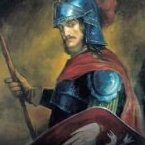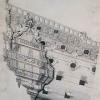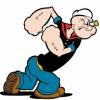-
Posts
3,084 -
Joined
-
Last visited
Reputation Activity
-
 Jaager got a reaction from pontiachedmark in Victory Constructo Ship worth
Jaager got a reaction from pontiachedmark in Victory Constructo Ship worth
A complete guess here:
POB, kit, subject that is probably one of the three most overdone : Victory, SOS, Constitution
Probably the same as the original kit.
I costed out the price of a finished model, if I based it on the $60/hr I was getting from my day job a decade ago - a billionaire would not pay that much. On a return per time expended, this is a charitable exercise at best.
-
 Jaager got a reaction from Canute in Home made thicknessing sander if
Jaager got a reaction from Canute in Home made thicknessing sander if
This has drifted a bit. For where this is now, I add the following:
at minimum a 1/3 HP TEFC motor with a final sanding drum rotation of 1700 rpm
If more than a few passes are contemplated per session, as much air circulation around the motor as can be had.
-
 Jaager got a reaction from Canute in Milling cherry logs
Jaager got a reaction from Canute in Milling cherry logs
Black Cherry is useful for most everything. The color would be a bit eccentric for spars and deck planking. But frames timbers, beams, hull planking, bits, a lot of antebellum merchantmen seemed to have clear finish Spanish Mahogany for hatch coming and similar trim and when oxidized - time - Black Cherry is an excellent miniature replication. If you have Sweet Cherry, the color is a lot less red, but the grain is about the same.
Now milling from logs is a different thing. To reduce checking and splits during the drying process, it is imperative that the cut ends and branch cuts be sealed. The last thing I used for this is left over latex enamel paint and used paper towels to glob on a thick coat. Anything liquid, which when dry blocks water.
3 inch logs on a 9" band saw - too thick - both for clearance and motor power. Find a local wood workers club and team up with someone with a larger band saw. Buy your own blade to fit his saw. Get a bimetal blade - initial cost is higher - all steel blades dull quickly and break when pushed when dull.
You need two perpendicular cuts. A log wants to roll. A 1/2" thick board - edge against the fence - riding on the table - Use right angle framing braces and long #10 or so screws to fix the log to this 1/2" carrier. After the first cut, the cut face goes on the board - After the second cut, the carrier is no longer needed.
I do 1:60 scale POF - 2 inch thick billets are working well foe me now. At least 2 years drying time for this.
-
 Jaager got a reaction from Canute in Unimat 1 Classic 6 in 1 Tool 83000 Power Tool
Jaager got a reaction from Canute in Unimat 1 Classic 6 in 1 Tool 83000 Power Tool
For the Unimat SL, which has a relatively short bed for masts, a denken experiment that uses the steady rest holding a ball bearing race - the OD just fitting the steady rest opening and ID in various sizes - close to the spar diameter - cardboard to fix and brace the wood. The end over end to shape the other end.
-
 Jaager got a reaction from Canute in Unimat 1 Classic 6 in 1 Tool 83000 Power Tool
Jaager got a reaction from Canute in Unimat 1 Classic 6 in 1 Tool 83000 Power Tool
It is my experience that there is not much on a ship model that requires a lathe. Most of that (spars) can be accomplished using an electric drill in a shop made clamp. The one part that would be difficult to fake - turning up 100 cannon - a lathe and pattern duplicator helps here.
The one function that requires a lathe is turning metal to fabricate your own tools. A machinists lathe is essentially a tool to make tools.
A mill is a bit more useful, but it too is a machine to make tools. It can act as an expensive drill press and allow you to bull thru wood with milling cut - not wise, probably messy. You can also avoid the expense and get a jewelers generic drill press and a Chinese XY table all for less than $200. The bearings are not designed for lateral stress, but with wood, sharp cutters and light cuts...
Right now, we have the great good luck in the presence of Jim Byrnes. The tool functions that you would find practically useful in a multi tool, he provides as single purpose machines that are about a hundred times better.
It you are still determined - visit Little Machine Shop for bench top mills and lathes
-
 Jaager got a reaction from Canute in Unimat 1 Classic 6 in 1 Tool 83000 Power Tool
Jaager got a reaction from Canute in Unimat 1 Classic 6 in 1 Tool 83000 Power Tool
I have a Unimat SL - It is now relegated to just the lathe function. I burned out a motor using it as a table saw. Everything but the lathe is better done by a single purpose machine. This even though it is a precise and well made unit.
Unimat I is neither precise nor well made. It is a toy. Buy it and feel the sentiment behind the message yelled at generations of army recruits: you'll be sorrrreeee.
-
 Jaager got a reaction from Bob Cleek in Milling cherry logs
Jaager got a reaction from Bob Cleek in Milling cherry logs
Black Cherry is useful for most everything. The color would be a bit eccentric for spars and deck planking. But frames timbers, beams, hull planking, bits, a lot of antebellum merchantmen seemed to have clear finish Spanish Mahogany for hatch coming and similar trim and when oxidized - time - Black Cherry is an excellent miniature replication. If you have Sweet Cherry, the color is a lot less red, but the grain is about the same.
Now milling from logs is a different thing. To reduce checking and splits during the drying process, it is imperative that the cut ends and branch cuts be sealed. The last thing I used for this is left over latex enamel paint and used paper towels to glob on a thick coat. Anything liquid, which when dry blocks water.
3 inch logs on a 9" band saw - too thick - both for clearance and motor power. Find a local wood workers club and team up with someone with a larger band saw. Buy your own blade to fit his saw. Get a bimetal blade - initial cost is higher - all steel blades dull quickly and break when pushed when dull.
You need two perpendicular cuts. A log wants to roll. A 1/2" thick board - edge against the fence - riding on the table - Use right angle framing braces and long #10 or so screws to fix the log to this 1/2" carrier. After the first cut, the cut face goes on the board - After the second cut, the carrier is no longer needed.
I do 1:60 scale POF - 2 inch thick billets are working well foe me now. At least 2 years drying time for this.
-
 Jaager got a reaction from Bob Cleek in Unimat 1 Classic 6 in 1 Tool 83000 Power Tool
Jaager got a reaction from Bob Cleek in Unimat 1 Classic 6 in 1 Tool 83000 Power Tool
For the Unimat SL, which has a relatively short bed for masts, a denken experiment that uses the steady rest holding a ball bearing race - the OD just fitting the steady rest opening and ID in various sizes - close to the spar diameter - cardboard to fix and brace the wood. The end over end to shape the other end.
-
 Jaager got a reaction from bruce d in Unimat 1 Classic 6 in 1 Tool 83000 Power Tool
Jaager got a reaction from bruce d in Unimat 1 Classic 6 in 1 Tool 83000 Power Tool
For the Unimat SL, which has a relatively short bed for masts, a denken experiment that uses the steady rest holding a ball bearing race - the OD just fitting the steady rest opening and ID in various sizes - close to the spar diameter - cardboard to fix and brace the wood. The end over end to shape the other end.
-
 Jaager got a reaction from moreplovac in Milling cherry logs
Jaager got a reaction from moreplovac in Milling cherry logs
Black Cherry is useful for most everything. The color would be a bit eccentric for spars and deck planking. But frames timbers, beams, hull planking, bits, a lot of antebellum merchantmen seemed to have clear finish Spanish Mahogany for hatch coming and similar trim and when oxidized - time - Black Cherry is an excellent miniature replication. If you have Sweet Cherry, the color is a lot less red, but the grain is about the same.
Now milling from logs is a different thing. To reduce checking and splits during the drying process, it is imperative that the cut ends and branch cuts be sealed. The last thing I used for this is left over latex enamel paint and used paper towels to glob on a thick coat. Anything liquid, which when dry blocks water.
3 inch logs on a 9" band saw - too thick - both for clearance and motor power. Find a local wood workers club and team up with someone with a larger band saw. Buy your own blade to fit his saw. Get a bimetal blade - initial cost is higher - all steel blades dull quickly and break when pushed when dull.
You need two perpendicular cuts. A log wants to roll. A 1/2" thick board - edge against the fence - riding on the table - Use right angle framing braces and long #10 or so screws to fix the log to this 1/2" carrier. After the first cut, the cut face goes on the board - After the second cut, the carrier is no longer needed.
I do 1:60 scale POF - 2 inch thick billets are working well foe me now. At least 2 years drying time for this.
-
 Jaager got a reaction from mtaylor in Milling cherry logs
Jaager got a reaction from mtaylor in Milling cherry logs
Black Cherry is useful for most everything. The color would be a bit eccentric for spars and deck planking. But frames timbers, beams, hull planking, bits, a lot of antebellum merchantmen seemed to have clear finish Spanish Mahogany for hatch coming and similar trim and when oxidized - time - Black Cherry is an excellent miniature replication. If you have Sweet Cherry, the color is a lot less red, but the grain is about the same.
Now milling from logs is a different thing. To reduce checking and splits during the drying process, it is imperative that the cut ends and branch cuts be sealed. The last thing I used for this is left over latex enamel paint and used paper towels to glob on a thick coat. Anything liquid, which when dry blocks water.
3 inch logs on a 9" band saw - too thick - both for clearance and motor power. Find a local wood workers club and team up with someone with a larger band saw. Buy your own blade to fit his saw. Get a bimetal blade - initial cost is higher - all steel blades dull quickly and break when pushed when dull.
You need two perpendicular cuts. A log wants to roll. A 1/2" thick board - edge against the fence - riding on the table - Use right angle framing braces and long #10 or so screws to fix the log to this 1/2" carrier. After the first cut, the cut face goes on the board - After the second cut, the carrier is no longer needed.
I do 1:60 scale POF - 2 inch thick billets are working well foe me now. At least 2 years drying time for this.
-
 Jaager got a reaction from mtaylor in Unimat 1 Classic 6 in 1 Tool 83000 Power Tool
Jaager got a reaction from mtaylor in Unimat 1 Classic 6 in 1 Tool 83000 Power Tool
For the Unimat SL, which has a relatively short bed for masts, a denken experiment that uses the steady rest holding a ball bearing race - the OD just fitting the steady rest opening and ID in various sizes - close to the spar diameter - cardboard to fix and brace the wood. The end over end to shape the other end.
-
 Jaager got a reaction from mtaylor in Unimat 1 Classic 6 in 1 Tool 83000 Power Tool
Jaager got a reaction from mtaylor in Unimat 1 Classic 6 in 1 Tool 83000 Power Tool
It is my experience that there is not much on a ship model that requires a lathe. Most of that (spars) can be accomplished using an electric drill in a shop made clamp. The one part that would be difficult to fake - turning up 100 cannon - a lathe and pattern duplicator helps here.
The one function that requires a lathe is turning metal to fabricate your own tools. A machinists lathe is essentially a tool to make tools.
A mill is a bit more useful, but it too is a machine to make tools. It can act as an expensive drill press and allow you to bull thru wood with milling cut - not wise, probably messy. You can also avoid the expense and get a jewelers generic drill press and a Chinese XY table all for less than $200. The bearings are not designed for lateral stress, but with wood, sharp cutters and light cuts...
Right now, we have the great good luck in the presence of Jim Byrnes. The tool functions that you would find practically useful in a multi tool, he provides as single purpose machines that are about a hundred times better.
It you are still determined - visit Little Machine Shop for bench top mills and lathes
-
 Jaager got a reaction from Bob Cleek in Unimat 1 Classic 6 in 1 Tool 83000 Power Tool
Jaager got a reaction from Bob Cleek in Unimat 1 Classic 6 in 1 Tool 83000 Power Tool
It is my experience that there is not much on a ship model that requires a lathe. Most of that (spars) can be accomplished using an electric drill in a shop made clamp. The one part that would be difficult to fake - turning up 100 cannon - a lathe and pattern duplicator helps here.
The one function that requires a lathe is turning metal to fabricate your own tools. A machinists lathe is essentially a tool to make tools.
A mill is a bit more useful, but it too is a machine to make tools. It can act as an expensive drill press and allow you to bull thru wood with milling cut - not wise, probably messy. You can also avoid the expense and get a jewelers generic drill press and a Chinese XY table all for less than $200. The bearings are not designed for lateral stress, but with wood, sharp cutters and light cuts...
Right now, we have the great good luck in the presence of Jim Byrnes. The tool functions that you would find practically useful in a multi tool, he provides as single purpose machines that are about a hundred times better.
It you are still determined - visit Little Machine Shop for bench top mills and lathes
-
 Jaager got a reaction from davyboy in Unimat 1 Classic 6 in 1 Tool 83000 Power Tool
Jaager got a reaction from davyboy in Unimat 1 Classic 6 in 1 Tool 83000 Power Tool
I have a Unimat SL - It is now relegated to just the lathe function. I burned out a motor using it as a table saw. Everything but the lathe is better done by a single purpose machine. This even though it is a precise and well made unit.
Unimat I is neither precise nor well made. It is a toy. Buy it and feel the sentiment behind the message yelled at generations of army recruits: you'll be sorrrreeee.
-
 Jaager got a reaction from bruce d in Unimat 1 Classic 6 in 1 Tool 83000 Power Tool
Jaager got a reaction from bruce d in Unimat 1 Classic 6 in 1 Tool 83000 Power Tool
I have a Unimat SL - It is now relegated to just the lathe function. I burned out a motor using it as a table saw. Everything but the lathe is better done by a single purpose machine. This even though it is a precise and well made unit.
Unimat I is neither precise nor well made. It is a toy. Buy it and feel the sentiment behind the message yelled at generations of army recruits: you'll be sorrrreeee.
-
 Jaager got a reaction from FrankWouts in The Saint-Philippe -1693 - Ancre
Jaager got a reaction from FrankWouts in The Saint-Philippe -1693 - Ancre
Kevin,
No matter how much jest is involved, unless you have access to a mansion sized building, either realization is a bit overwhelming.
The Cutty Sark would be easier, but larger. At 1:48 a masted model is for all intents 6 feet long and about that tall. The Saint-Philippe is about 6 inches shorter. I have lofted Philippe at 1:120 and played with the framing. The hull is about the size of a brig: USS Porpoise at 1:60. Having second thoughts about doing a miniature, I looked at redoing the timbers at 1:60 using Navy Board style framing. I hit breaks real fast when it demonstrated that the mid ship floor timber is too large to be had from a 2 inch wide piece of stock. And the mid ship floor is the straightest, least carnivorous floor. A POF at 1:36 ---- a Baby Huey that needs lots and lots of lumber to frame. Framing at 1:48 would put a serious hurt on a 50 bf lumber stock.
If you were just married when you started these two, you would possibly be paying for your kid's college when you finished.
The Saint-Philippe is a late 17th century first rate with magnificent excess in its decoration. It could easily stand as a magnificent magnum opus for any modeler.
-
 Jaager got a reaction from Hubac's Historian in The Saint-Philippe -1693 - Ancre
Jaager got a reaction from Hubac's Historian in The Saint-Philippe -1693 - Ancre
Kevin,
No matter how much jest is involved, unless you have access to a mansion sized building, either realization is a bit overwhelming.
The Cutty Sark would be easier, but larger. At 1:48 a masted model is for all intents 6 feet long and about that tall. The Saint-Philippe is about 6 inches shorter. I have lofted Philippe at 1:120 and played with the framing. The hull is about the size of a brig: USS Porpoise at 1:60. Having second thoughts about doing a miniature, I looked at redoing the timbers at 1:60 using Navy Board style framing. I hit breaks real fast when it demonstrated that the mid ship floor timber is too large to be had from a 2 inch wide piece of stock. And the mid ship floor is the straightest, least carnivorous floor. A POF at 1:36 ---- a Baby Huey that needs lots and lots of lumber to frame. Framing at 1:48 would put a serious hurt on a 50 bf lumber stock.
If you were just married when you started these two, you would possibly be paying for your kid's college when you finished.
The Saint-Philippe is a late 17th century first rate with magnificent excess in its decoration. It could easily stand as a magnificent magnum opus for any modeler.
-
 Jaager got a reaction from mtaylor in Unimat 1 Classic 6 in 1 Tool 83000 Power Tool
Jaager got a reaction from mtaylor in Unimat 1 Classic 6 in 1 Tool 83000 Power Tool
I have a Unimat SL - It is now relegated to just the lathe function. I burned out a motor using it as a table saw. Everything but the lathe is better done by a single purpose machine. This even though it is a precise and well made unit.
Unimat I is neither precise nor well made. It is a toy. Buy it and feel the sentiment behind the message yelled at generations of army recruits: you'll be sorrrreeee.
-
 Jaager got a reaction from Kevin in The Saint-Philippe -1693 - Ancre
Jaager got a reaction from Kevin in The Saint-Philippe -1693 - Ancre
Kevin,
No matter how much jest is involved, unless you have access to a mansion sized building, either realization is a bit overwhelming.
The Cutty Sark would be easier, but larger. At 1:48 a masted model is for all intents 6 feet long and about that tall. The Saint-Philippe is about 6 inches shorter. I have lofted Philippe at 1:120 and played with the framing. The hull is about the size of a brig: USS Porpoise at 1:60. Having second thoughts about doing a miniature, I looked at redoing the timbers at 1:60 using Navy Board style framing. I hit breaks real fast when it demonstrated that the mid ship floor timber is too large to be had from a 2 inch wide piece of stock. And the mid ship floor is the straightest, least carnivorous floor. A POF at 1:36 ---- a Baby Huey that needs lots and lots of lumber to frame. Framing at 1:48 would put a serious hurt on a 50 bf lumber stock.
If you were just married when you started these two, you would possibly be paying for your kid's college when you finished.
The Saint-Philippe is a late 17th century first rate with magnificent excess in its decoration. It could easily stand as a magnificent magnum opus for any modeler.
-
 Jaager got a reaction from Canute in Briar Pipe by Papa - FINISHED
Jaager got a reaction from Canute in Briar Pipe by Papa - FINISHED
Is Briar available as solid blocks or billets? Apart from the grain pattern, it might make for hardy blocks. Did the wood handle like it would work for that?
-
 Jaager got a reaction from popeye the sailor in Briar Pipe by Papa - FINISHED
Jaager got a reaction from popeye the sailor in Briar Pipe by Papa - FINISHED
Is Briar available as solid blocks or billets? Apart from the grain pattern, it might make for hardy blocks. Did the wood handle like it would work for that?
-
 Jaager got a reaction from pontiachedmark in HHardacre
Jaager got a reaction from pontiachedmark in HHardacre
The material that binds wood fibers - lignin - is not water soluble. It is soluble in anhydrous ammonia, an explosive and dangerous industrial agent.
It is not soluble in household (5%) or 20% ammonia. These just damage the planking. Heat will loosen lignin and allow for more bending.
Water on the surface of the wood - when contacted by a dry heat source - becomes steam and penetrates the wood with more efficiency than just dry heat alone. A microwave and wet paper towel wrapping, or direct steam will work. Soaking in hot water works - but sort of reverses the original seasoning process a bit. Ideal is to let the bent wood dry in its future conformation. If you dry in an over bent conformation, try to keep that at a slight amount.
-
 Jaager got a reaction from mtaylor in DAUPHIN ROYAL 1668 by Heinrich der Seefahrer - 1/36 - Transom and side gallery model
Jaager got a reaction from mtaylor in DAUPHIN ROYAL 1668 by Heinrich der Seefahrer - 1/36 - Transom and side gallery model
About the hull - the basic method - explained in Deane's Doctrine - involves the heavy use of arcs. Because pieces of circles make up the cross sections and transitions between them to try to get a reasonable run along the hull make up the waterlines, there is a basic sameness in the shape below the main wale. If you can get lines for a ship about the same age and size, they can be scale adjusted to the beam, depth, and length to your ship. The result would likely be "close enough for government work".
-
 Jaager got a reaction from JeffT in HHardacre
Jaager got a reaction from JeffT in HHardacre
If the bend in the thick dimension proves difficult - wood does not readily comply to doing that - start with a wider plank and spill it to the up curve.
Spill = spoil = waste a lot of wood cutting an "S" shape. That is how it was really done - mostly. The database here has planking tutorials the explain all this.











